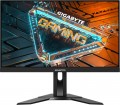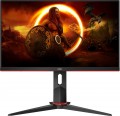Pixel size
The size of one dot (pixel) on a monitor screen. This parameter is related to the maximum resolution of the monitor and its diagonal size — the higher the resolution, the smaller the pixel size (with the same diagonal) and vice versa, the larger the diagonal, the larger the size of one pixel (with the same resolution). The smaller the size of one pixel, the clearer the image will be displayed by the monitor, the less grainy it will be noticeable, which is especially important on large monitors. On the other hand, a small pixel size creates discomfort when working with fine details and text — this mainly applies to monitors with a small diagonal.
Response time (GtG)
The time each individual pixel on the monitor takes to switch from one state to another. The
lower the response time, the faster the matrix responds to the control signal, resulting in less delay and better image quality in dynamic scenes.
Note that in this case, the gray-to-gray method is used (the time it takes to switch from 10% gray to 90% gray). Pay attention to this parameter if the monitor is specifically purchased for fast-paced games, movie watching, or other applications involving quick screen movements. However, there’s no need to chase the fastest models. It’s not often possible to discern the difference between
1 ms and
5 ms. For most scenarios,
monitors with a 4 ms response time will suffice. In any case, it’s best to rely on live impressions for a true comparison.
Static contrast
Static contrast provided by the monitor screen.
This value describes the difference between the brightest whites and darkest blacks that the screen is capable of producing. In this case, unlike dynamic contrast (see below), the difference is indicated on the condition that the brightness of the screen backlight remains unchanged. In other words, this is the contrast that is guaranteed to be achievable within one frame. Static contrast is inevitably lower than dynamic. However, it is she who describes the basic capabilities of the screen.
The minimum static contrast ratio for tolerable image quality is considered to be 250:1, but even the most modest modern monitors give out about 400:1 (and a value of
1000:1 is not the highest class), and in high-end models this figure can reach 2000:1 and even more. .
Dynamic Contrast
Dynamic contrast provided by the monitor screen.
Dynamic contrast refers to the difference between the brightest white at maximum backlight intensity and the deepest black at minimum backlight. In this way, this indicator differs from static contrast, which is indicated with a constant backlight level (see above). Dynamic contrast ratio can be expressed in very impressive numbers (in some models — more than 100,000,000: 1). However, in fact, these figures are poorly correlated with what the viewer sees: it is almost impossible to achieve such a difference within one frame. Therefore, dynamic contrast is most often more of an advertising than a practically significant indicator, it is often indicated precisely in order to impress an inexperienced buyer. At the same time, we note that there are "smart" backlight technologies that allow you to change its brightness in certain areas of the screen and achieve a higher contrast in one frame than the claimed static one; these technologies are found mostly in premium monitors.
Colour depth
The colour depth supported by the monitor.
This parameter characterizes the number of shades that the screen can display. And here it is worth recalling that the image in modern monitors is based on 3 basic colours — red, green, blue (RGB scheme). And the number of bits is indicated not for the entire screen, but for each base colour. For example, 6 bits (the minimum colour depth for modern monitors) means that the screen is capable of producing 2 ^ 6, that is, 64 shades of red, green and blue; the total number of shades will be 64 * 64 * 64 = 262,144 (0.26 million). An
8-bit colour depth (256 shades for each base colour) already gives a total of 16.7 million colours; and the most advanced modern monitors support
10-bit colour, allowing you to work with more than a billion shades.
Screens with support for FRC technology are worth a special mention; nowadays, you can find models marked "
6 bit + FRC " and "
8 bit + FRC ". This technology was developed to improve picture quality in situations where the incoming video signal has a greater colour depth than the screen, such as when 10-bit video is fed to an 8-bit matrix. If such a screen supports FRC, the picture on it will be noticeably better than on a regular 8-bit monitor (although somewhat worse than on a full-fledged 10-bit monitor, but “8 bit + FRC” screens are much
...cheaper).
High colour depth is important primarily for professional graphics and other tasks that require high colour fidelity. On the other hand, such features significantly affect the cost of the monitor. In addition, it is worth remembering that the quality of colour reproduction depends not only on the colour depth, but also on other parameters — in particular, colour gamut (see below).Colour space (NTSC)
The colour gamut of the monitor is based on the NTSC colour model.
Any colour gamut is indicated as a percentage, however, not relative to the entire variety of visible colours, but relative to the conditional colour space (colour model). This is due to the fact that no modern screen is able to display all the colours visible to humans. However, the larger the colour gamut, the wider the monitor's capabilities, the better its colour reproduction.
Specifically, NTSC is one of the first colour models created back in 1953 with the advent of colour television. It is not used in the production of modern monitors, but is often used to describe and compare them. NTSC covers a wider range of colours than sRGB, which is standard in computer technology: for example, coverage of only 85% in NTSC gives about 110% in sRGB. So the colour gamut for this model is usually given for advertising purposes — as a confirmation of the high class of the monitor; a very good indicator in such cases is considered to be
75% or more.
Colour space (sRGB)
Monitor colour gamut Rec. 709 or sRGB.
Any colour gamut is indicated as a percentage, however, not relative to the entire variety of visible colours, but relative to the conditional colour space (colour model). This is due to the fact that no modern screen is able to display all the colours visible to humans. However, the larger the colour gamut, the wider the monitor's capabilities, the better its colour reproduction.
Nowadays, sRGB is actually the standard color model adopted for computer technology; This is what is used in the development and production of most video cards. For television, the Rec. standard, similar in parameters, is used. 709. In terms of the range of colors, these models are identical, and the percentage of coverage for them is the same. In the most advanced monitors it can
reach or even exceed 100%; These are the values that are considered necessary for high-end screens, incl. professional.
Colour space (Adobe RGB)
Monitor colour gamut based on the Adobe RGB colour model.
Any colour gamut is indicated as a percentage, however, not relative to the entire variety of visible colours, but relative to the conditional colour space (colour model). This is due to the fact that no modern screen is able to display all the colours visible to humans. However, the larger the colour gamut, the wider the monitor's capabilities, the better its colour reproduction.
Specifically, the Adobe RGB colour model was originally developed for use in printing; the range of colours covered by it corresponds to the capabilities of professional printing equipment. Accordingly, support for this model and its extensive colour gamut are important, first of all, if the monitor is used in the design and layout of high-quality printed products. In the most advanced screens, this figure can be
99% or even more. At the same time, we note that Adobe RGB is wider than the popular sRGB, and the percentage figures for this model are smaller: for example, 99% in RGB often gives only about 87% in Adobe RGB.
Colour gamut (DCI-P3)
The color gamut of the monitor according to the DCI P3 color model.
Any color gamut is indicated in percentages, but not relative to the entire variety of visible colors, rather relative to a conventional color space (color model). This is because no modern screen can display all the colors visible to the human eye. Nevertheless, the larger the color gamut, the broader the monitor's capabilities, and the better its color reproduction quality.
DCI P3 is a professional color model mainly used in digital cinemas. It is significantly broader than the standard sRGB, providing more accurate and high-quality colors. Accordingly, the percentage values are lower—for example, 115% coverage in sRGB corresponds to approximately 90% coverage in DCI P3; in the most advanced modern monitors, coverage according to this standard is
98 – 100%. At the same time, supporting DCI-P3 is costly, which is why it is mainly found in high-end monitors for professional and gaming purposes.

